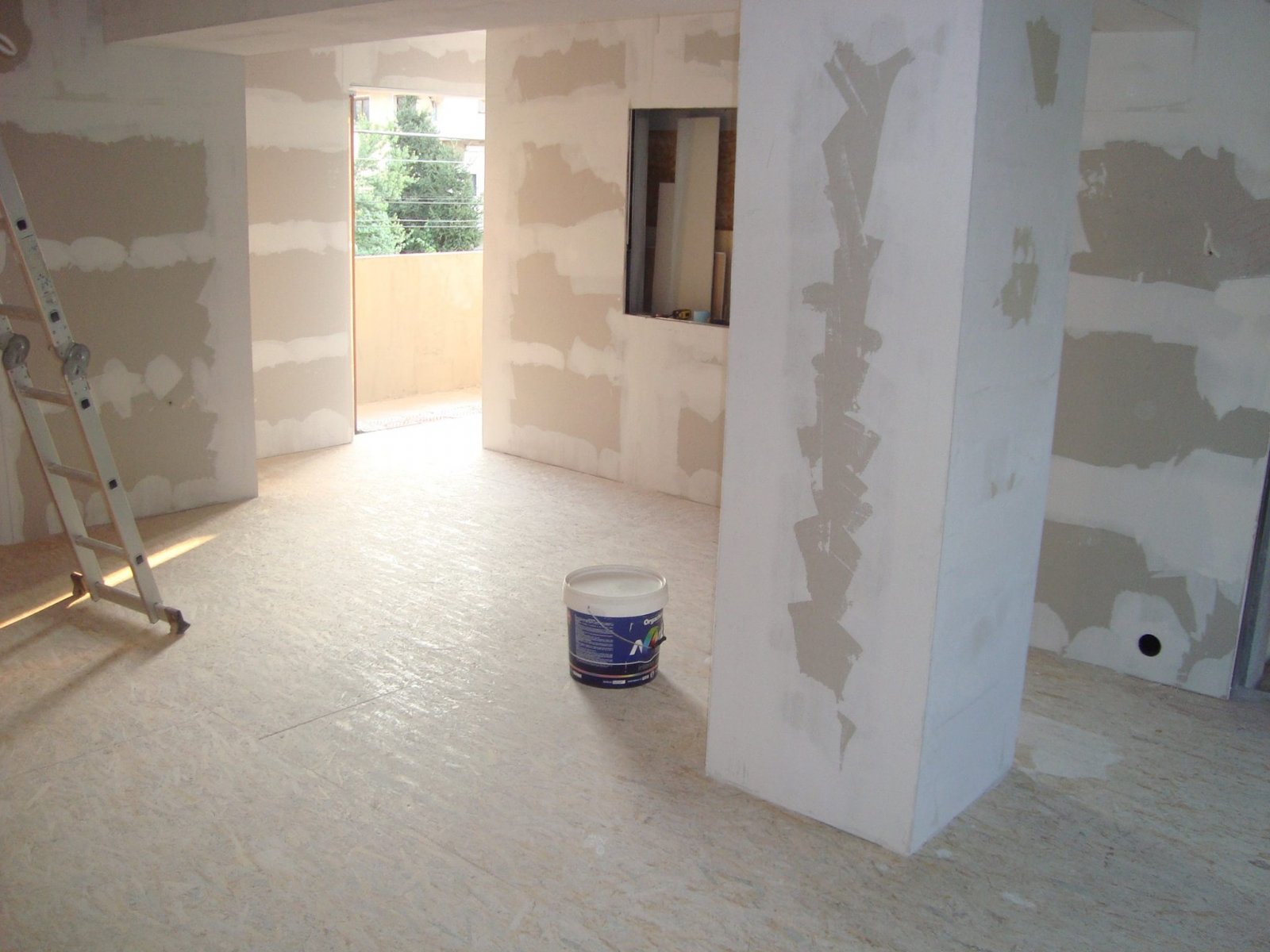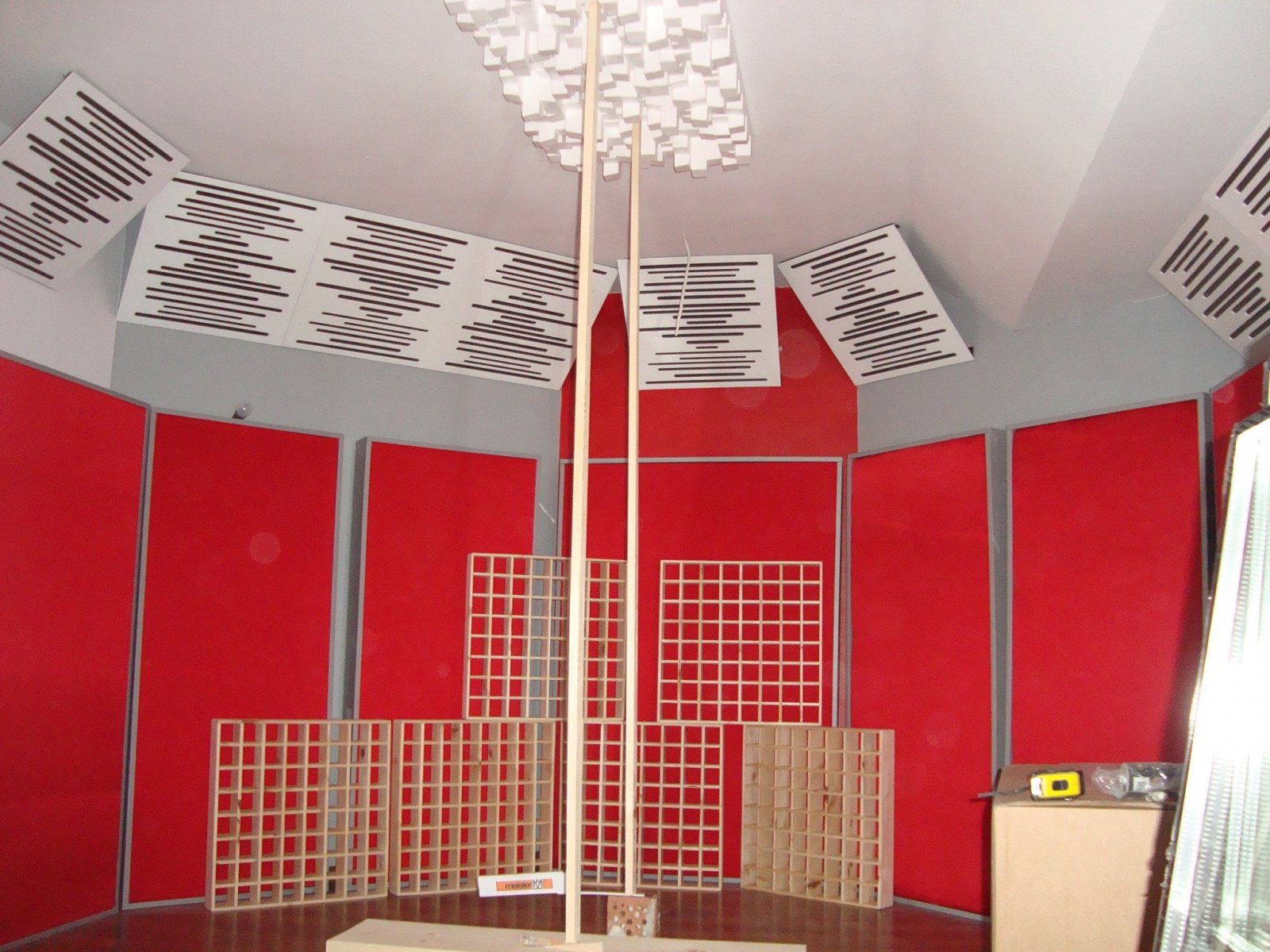Comments
They say a picture is worth a thousand words, but what is it tha
They say a picture is worth a thousand words, but what is it that you are doing?
Do you know how much this room:
http://recording.org/attachments/11914701_10200946364979375_2054677541998791443_o-jpg.12782/
is going to focus sound?
Brien Holcombe, post: 431638, member: 48996 wrote: They say a pi
Brien Holcombe, post: 431638, member: 48996 wrote: They say a picture is worth a thousand words, but what is it that you are doing?
Do you know how much this room:
http://recording.org/attachments/11914701_10200946364979375_2054677541998791443_o-jpg.12782/
is going to focus sound?
I hope that I will have no big problems.This room is made by golden ratio dimantion.
The floor is flooting above the concrete by 6 inch.Also that red absorbers are made from stone wool 95 kw3. and they are 5.5 inch thick.
pan60, post: 431685, member: 40762 wrote: What size is the room
pan60, post: 431685, member: 40762 wrote: What size is the room and are those corners set up as large bass traps?
It is hard to see the layout just see one part of the room.
:)
The size is in centimeters;
HIgh 235 cm
With 378 cm
and lenght 554 cm
The grey corners are made from,
behind- nothing аir,
Then rock wool 10cm- 95kv3
then gypsum,
then vinil(rubber)
then again gypsum
3 layer total.
All walls are made the same.The floor is 4 layers .
I will post all pictures from start to finish and every step is there.
Brien Holcombe, post: 431699, member: 48996 wrote: I have a lot
Brien Holcombe, post: 431699, member: 48996 wrote: I have a lot of concern with the way this build was developed...from the floor to the shape to what you just described.
So, it would be better if you first post the response data from your testing of this room rather than dump a zillion pretty pix ¥)
Ok man,I have same finishing jobs to do and then will test with analizers and so on...
Have a look here.All things are made how these moves recomendet.
http://www.macprovideo.com/tutorial/thestudioedge101-planning-a-recording-studio
http://www.macprovideo.com/tutorial/thestudioedge102-constructing-and-fine-tuning-your-studio
http://www.macprovideo.com/tutorial/thestudioedge-103-case-study-the-home-studio
Brien Holcombe, post: 431699, member: 48996 wrote: I have a lot
Brien Holcombe, post: 431699, member: 48996 wrote: I have a lot of concern with the way this build was developed...from the floor to the shape to what you just described.
So, it would be better if you first post the response data from your testing of this room rather than dump a zillion pretty pix ¥)
The floor is like this with auralex U boats
https://www.google.bg/search?q=auraleh+floor&rlz=1C1KMZB_enBG536BG536&espv=2&biw=1536&bih=783&source=lnms&tbm=isch&sa=X&ved=0CAYQ_AUoAWoVChMIxOiUlMCzxwIVifByCh1bHg6d#tbm=isch&q=auralex+floor
Also the walls is like this
http://auralex.ihostsolutions.net/gallery/images/mfi_3co.jpg
I hope that you are not right that this room will not sound good.
Soon I wiil install all my studio gear and the show time begins.
And I think that you are right about the pictures-they are pretty(that is the point)and they are honest to the originals.
I think the issue is the that sound reflection will have a focal
I think the issue is the that sound reflection will have a focal point based on the corners and the reflective surface's.
It may not be as big an issue with the absorption you have, but I would have left square them stuffed mass absorption in them.
It looks very nice and a lot of work their but I tend to agree Brien, it look like it my not have a great sound field.
pan60, post: 431702, member: 40762 wrote: I think the issue is t
pan60, post: 431702, member: 40762 wrote: I think the issue is the that sound reflection will have a focal point based on the corners and the reflective surface's.
It may not be as big an issue with the absorption you have, but I would have left square them stuffed mass absorption in them.
It looks very nice and a lot of work their but I tend to agree Brien, it look like it my not have a great sound field.
The back wall will be whole with absorbers-8 cm of rock wool 70kw3.
By the way I fill very good sound when I clap with hands,not dead not to reflective no funy resonans.Soon will see and hear that f...ing room...
pan60, post: 431707, member: 40762 wrote: I like a less reflecti
pan60, post: 431707, member: 40762 wrote: I like a less reflective room so I only cover absorption if absolutely necessary.
The absorption you have may be the saving grace?
I am agree with you,I want balanced room,not dead not reflective.
That big corners at 45 degrees are not my freak.The bulding has main constuction colon that can not be remove in the right corner.And I deside to make the same 45 degrees corner to the left side also.
But the red absorbers are big and thick with roock wool 95kw3 and they are 13 cm.Also they are about 10 cm from the walls.Also the are movable,I can move close to the wall or far from them.I can achive about 30 cm into the room .
pan60, post: 431702, member: 40762 wrote: It looks very nice and
pan60, post: 431702, member: 40762 wrote: It looks very nice and a lot of work their but I tend to agree Brien, it look like it my not have a great sound field.
I did not say that. I said it will focus the sound, big difference. It may well turn out to be a useable room, I would not have recommended building it this way as it cost way more than it should have to get what could well be lesser results.
Time will tell.
But test it and see...if it works for you that is the important thing.
But as an outline of how it should be designed and built we have to be careful of grabbing things off the Internet and trusting them as truth, especially if it is a picture from someone who makes a living selling these kinds of materials.
They can be the worst offenders. And as it applies to this job, they are ;)
Brien Holcombe, post: 431713, member: 48996 wrote: I did not say
Brien Holcombe, post: 431713, member: 48996 wrote: I did not say that. I said it will focus the sound, big difference. It may well turn out to be a useable room, I would not have recommended building it this way as it cost way more than it should have to get what could well be lesser results.
Time will tell.
If the sound is focused in the one end then I would say it would not have a great sound field.
Maybe my reply should have been worded word for word like yours?
I don't stop in here to argue.
I agree with you in that the one end of the room will possibly focus the sound or as I put it, it my not have a great sound field. But I suspect with the degree of absorption and depending on what the room gets used for it will be okay.
[quoote]"Maybe my reply should have been worded word for word li
[quoote]"Maybe my reply should have been worded word for word like yours?
I don't stop in here to argue."
Maybe next time.
The term "sound field" relates to the entire region, sound pressure, wave length et. al. When sound is "focused" it is due to the container that transmits the sound along the curved boundaries that exist in the parabolic shape.
This room is bordering on a parabolic shape. It is close enough that I am curious if there will be any separation at all.
Angel72 said that it was based on a golden ratio, but the ratios only fit cuboid. Once the shape changes the ratio is no longer an effective way to determine waves and the interaction with the boundaries of the room in question. You would have to ray trace the newly defined container to better understand where the hot spots moved.
My goal is not now nor in the beginning to shoot this down. Far from it. While I recognize that far too many people will build what they think will work...sometimes it actually works, just not in the way that the builder thought from the start.
So when I say "focus" I mean that, sans the treatment, you could whisper on one side of the room and he could hear you on the other with little to no amplification or drop in signal. That would work left to right, right to left and maybe even over the ceiling both ways as well.
And that is far far from a sound field.
What are the panels that you have mounted on a down-facing angle
What are the panels that you have mounted on a down-facing angle between the walls and the ceiling above the red BB panels? I'm referring to the panels with the varied-length horizontal slits; ( not referring to the diffusor on the ceiling...) what is their intended purpose?
Just curious...
DonnyThompson, post: 431930, member: 46114 wrote: What are the p
DonnyThompson, post: 431930, member: 46114 wrote: What are the panels that you have mounted on a down-facing angle between the walls and the ceiling above the red BB panels? I'm referring to the panels with the varied-length horizontal slits; ( not referring to the diffusor on the ceiling...) what is their intended purpose?
Just curious...
The panels are Vicoustic Wood panels(http://www.vicoustic.com/music-broadcast/products/acoustic-treatment/panel/415
They work like a bass traps and diffusors.
''Wave Wood can also be highly effective in controlling low frequencies when fitted in the corners of a room and used as a bass trap.''
A quote from the vicoustic: "Wave Wood is made from a combinati
A quote from the vicoustic:
"Wave Wood is made from a combination of acoustic foam and wood. Its instantly recognizable design results from unique research based on the acoustic properties of the wood and foam combined with non-linear sequential cavities that enable Wave Wood to act as both an absorber and diffuser. It is particularly effective in treating medium and high frequencies as well as solving issues such as flutter echoes. Wave Wood can also be highly effective in controlling low frequencies when fitted in the corners of a room and used as a bass trap."
I'm curious how this flat front panel with slots cut into is 'acting' like a diffuser. Or are they just popping in some key words to catch more buyers.
My main concern with a product like this, is its data presented doesnt look better in its most efficient area (250-1k) than typical 3pcf 4" rigid fiber/wool batts mounted on a wall (which exceed 1 in NRC in that area). In the rest of the spectrum the NRC ratings are about half of said typical rigid batts. This is the result of covering a material like that with the semi reflective wood, its surface area, and slot widths, in general.
Also questionable is the mounting used for the presented graph. There is no indication of its performance when for instance used for "flutter echoes" vs "low frequencies when in corners of a room and used as a bass trap". Which one are we looking at?
Effective bass trapping is usually quite large, and may or may not be tuned to certain frequency bands. This products claims to be effective at mid/high absorbsion, low end control, and diffusitive. seems again, more token words and phrases to sell stuff. Yet shows a graph where it's most efficient is in absorbing low mids/mids.
Product availability in areas make these things unique, but surely there are more affordable ways to get this done, DIY or not.
I would love to hear from vivacoustics, on how they're panel acts as a diffuser at all.!?
Why does it use all these catch words for marketing, and then At the bottom, classify correctly as a mid absorber. Lol
I'm by no means an expert, and all my studio building has been b
I'm by no means an expert, and all my studio building has been based on collected information and an 'averaging' of advice from many sources, but I'm very curious as to why you have built all the sound treatment devices before you finished the room. My own experience was that following the guides produced good sounding rooms in the main, but they all needed some treatment to solve issues I had not predicted. So a few traps, diffusers and other devices fitted to solve problems I detected once virtually complete. I'd have wanted to hear the room first, before installing the treatment which may be essential or pointless. How do you know? Finding your room has a honk at a certain frequency can be treated but in one I did, with a big mixer, the sound changed drastically once the mixer was installed. Yours looks really nice, but I'm not sure about you, but because I am not an expert many of my predictions were wrong. Some, I'm not even sure what made me install them. I spent quite a bit of extra construction time building a big bass trap, that expanded into a void above the rear of the mix position. It worked so well, there was a lack of bass - and sealing the damn thing off improved the sound, which was not what the book I used said would happen.
Paulears, I love you !! I've been crucified a few times this yea
Paulears, I love you !! I've been crucified a few times this year because I was saying the same thing, Why not actually listen to or analyse the room before starting to treat it.
I've been bashed away from a few threads and I completely get that you can make calculations or do basic stuff just to reduce fluter echo... but even then we can create more problems instead of fixing some.. Ah who knows, I might begin to understand room acoustic in some distant future !! ;)
I've read all the books people have pointed me to, but often the
I've read all the books people have pointed me to, but often they vary, and although I've tried to follow the rules and guidelines, sometimes events just conspire against me, and I take a sensible guess. All the magical room ratios for example. For practical reasons I've not been able to follow them, and so far, probably by luck, my variations have been easy enough to make sound good. I remember the boxy sound of one smaller studio and the parallel walls. Next design ended up a little coffin shaped but sounded nicer. I have no idea if the non-parallel surfaces made the change, or the slightly different ratios? Nowadays, there are so many treatments available, that leaving the thing as it is and then sorting out problems is easier than trying to predict the exact problem before. Obviously, some room problems are very well documented and repeated over and over again as people make the same mistakes. The problem curves and coincident reflections from multiple surfaces can be drawn on a bit of graph paper and hopefully avoided.
Treatment isn't cheap, so I've waited and played music and then had a listen, and fiddled with solutions. Not scientific but much more economic. What I really like in the OPs pictures is the visible end result, which is very nicely designed.
You'll acheive far better isolation if you remove the drywall fr
You'll acheive far better isolation if you remove the drywall from the existing walls on the inside of the room. If your careful you can use it to pack some wall bays, increasing isolation.
I'm not sure if you are just posting to show us what your doing, or if you want advice, but there are many things with your project that are 'wrong' in a sense that certain techniques have been tested for acoustic performance. And if your wise, you the same amount of materials and $ can outperforms other construction techniques.
For instance that deck should have been slightly 'overstuffed' w the insulation so it comes in contact w the plywood, and dampens it, similar to 'moon gels' on a drumkit. Filling wood framed decks with sand is often the reccomended method for this, I think due to cost, and an edge in mass over the Rockwool type.
That corner near the window, may be better off, being framed squarely instead of straddled . This adds precious cubic footage, and then you make a traiagular bass trap, in that square corner, as part of the acoustic treatment layer. They end up looking the same, but performing far far differently.
I'm not trying to rain on your parade, rather, I'm curious if your interested in improving your rooms performance, with what you already have as far as materials, or simply looking to show us what your doing.
I'll shut up with the technical advice if your not interested, as I'm trying to not be a downer. I've just built some things in the past that underperformed, and it was directly related to me having 'bright ideas' and not checking that facts first.
Best of luck.
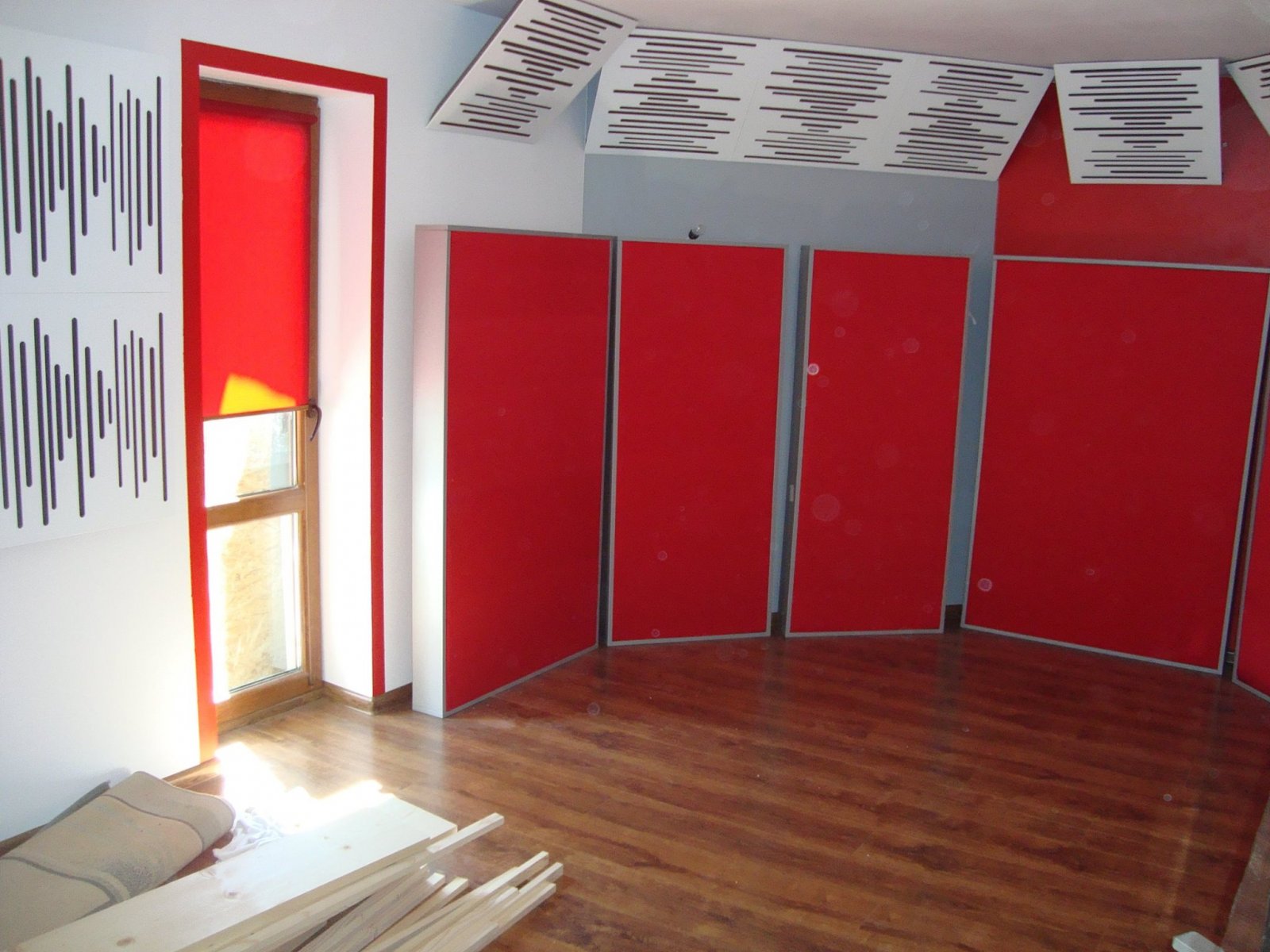
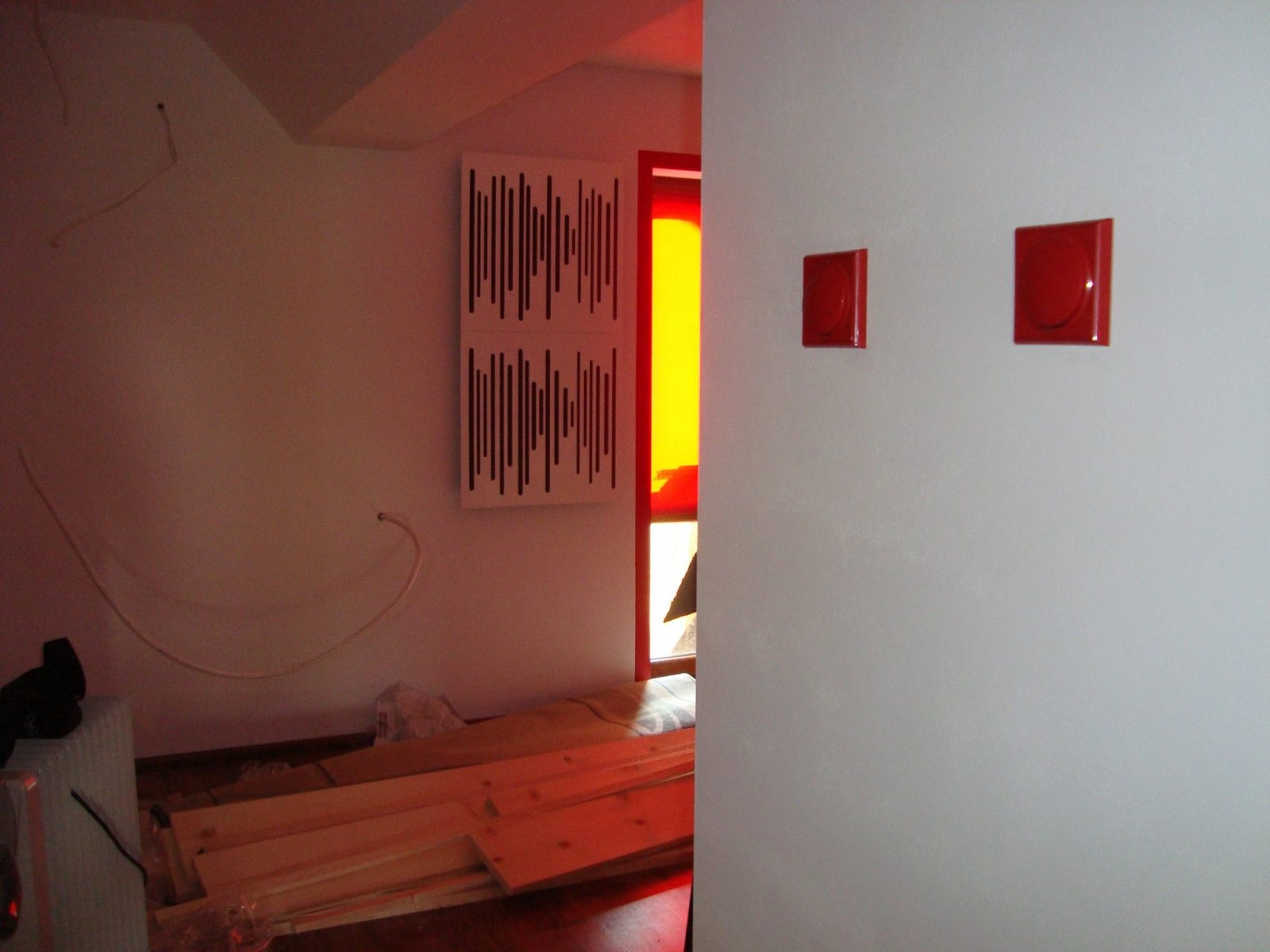
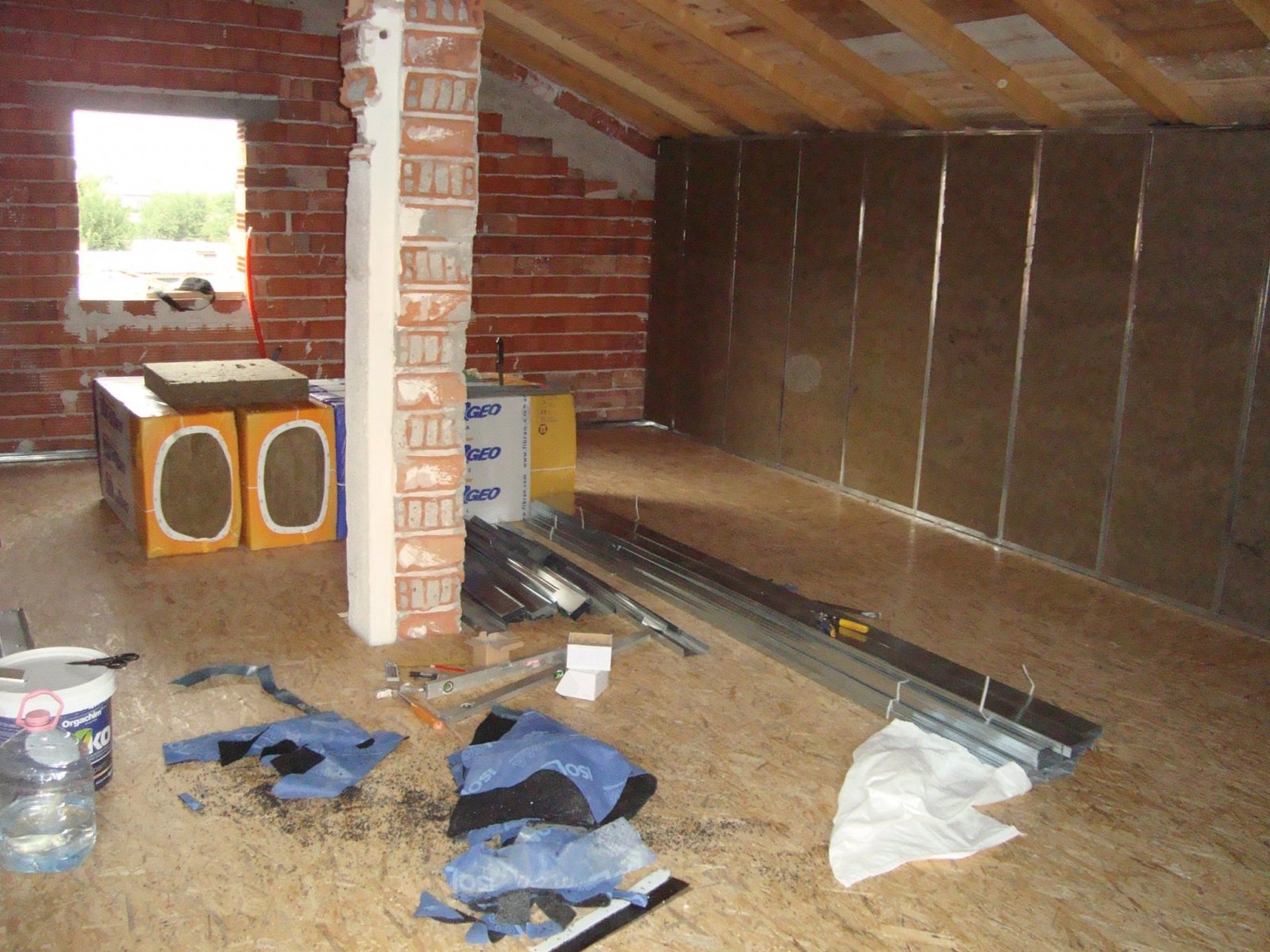
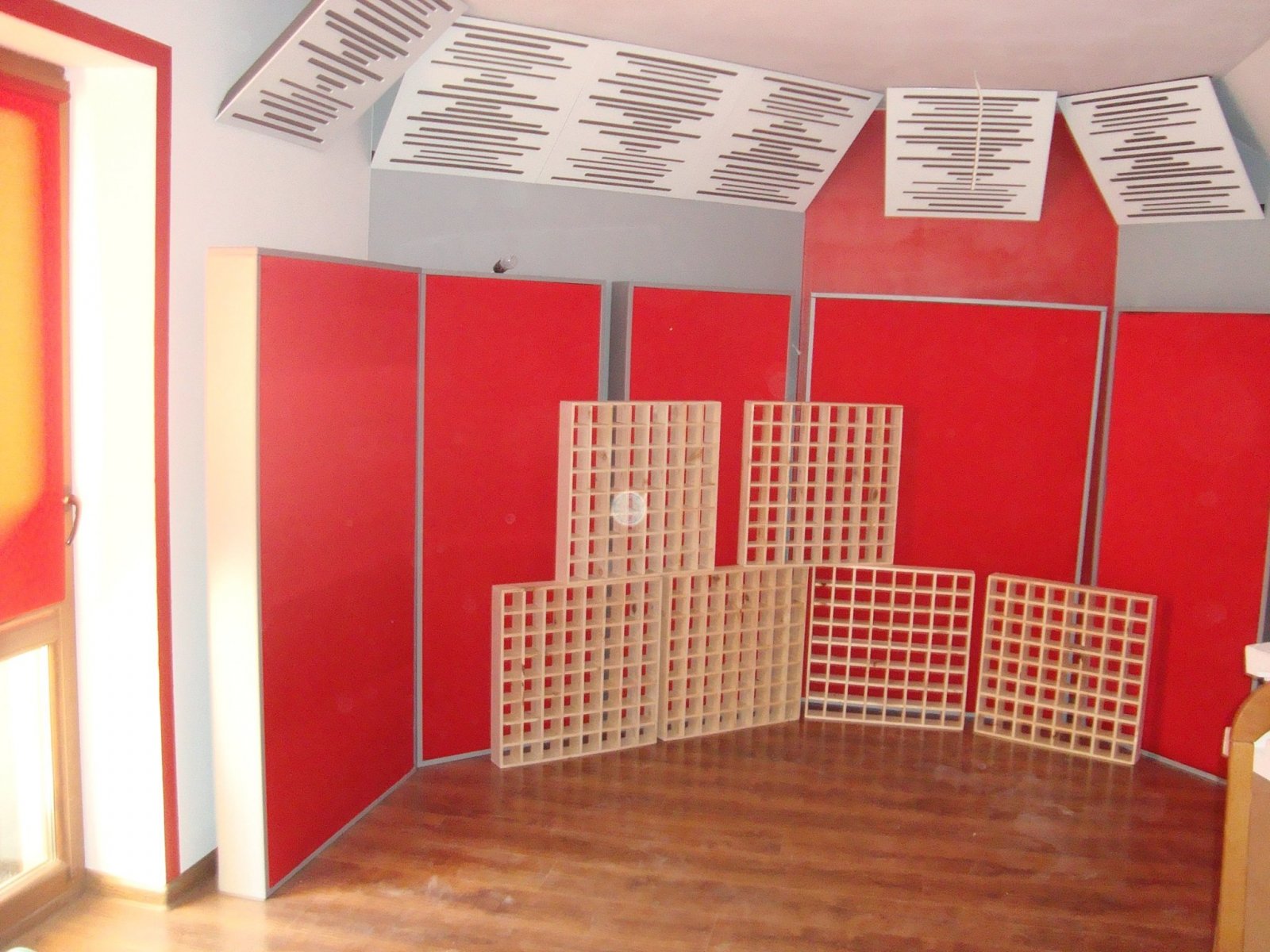
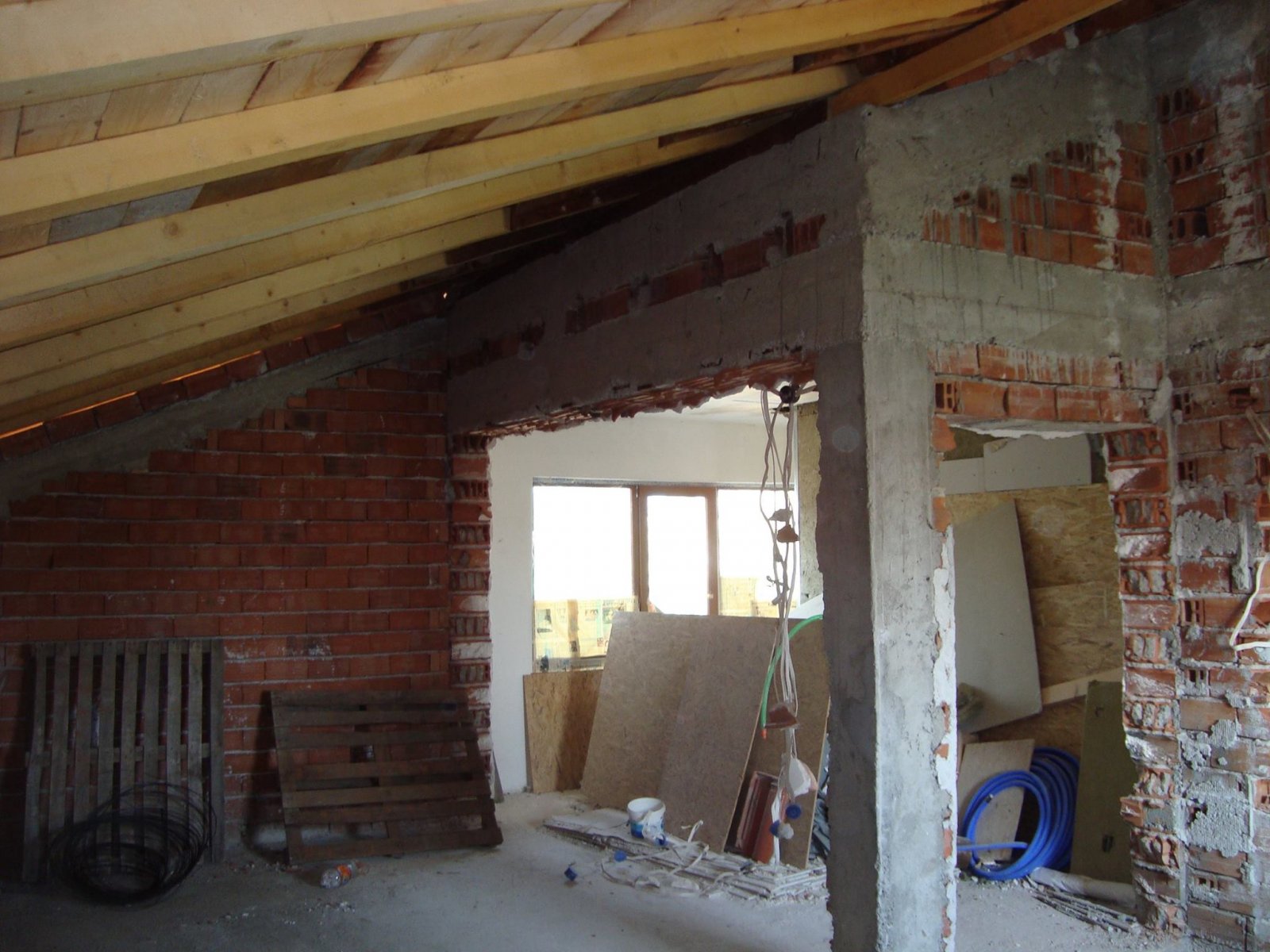



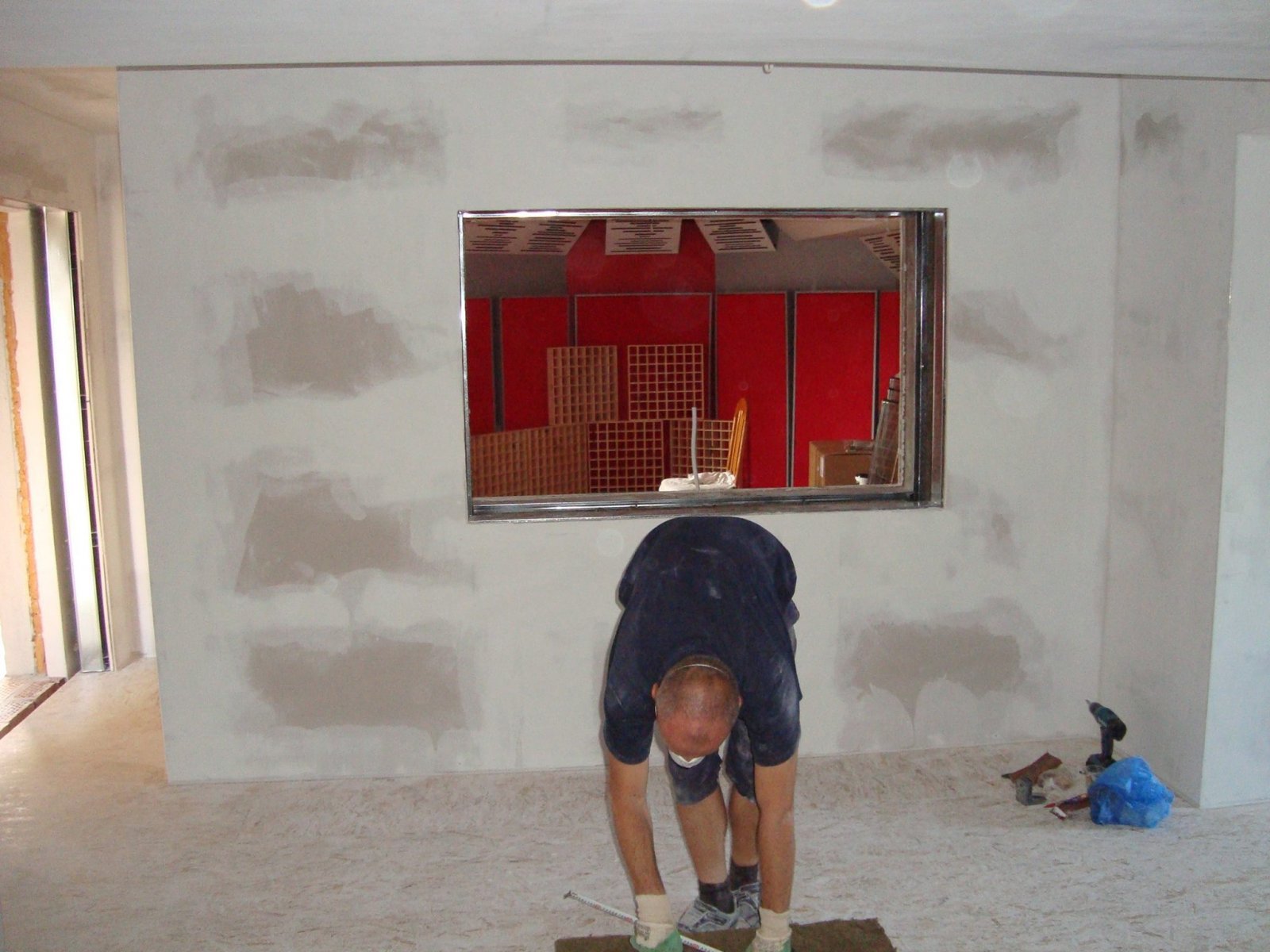


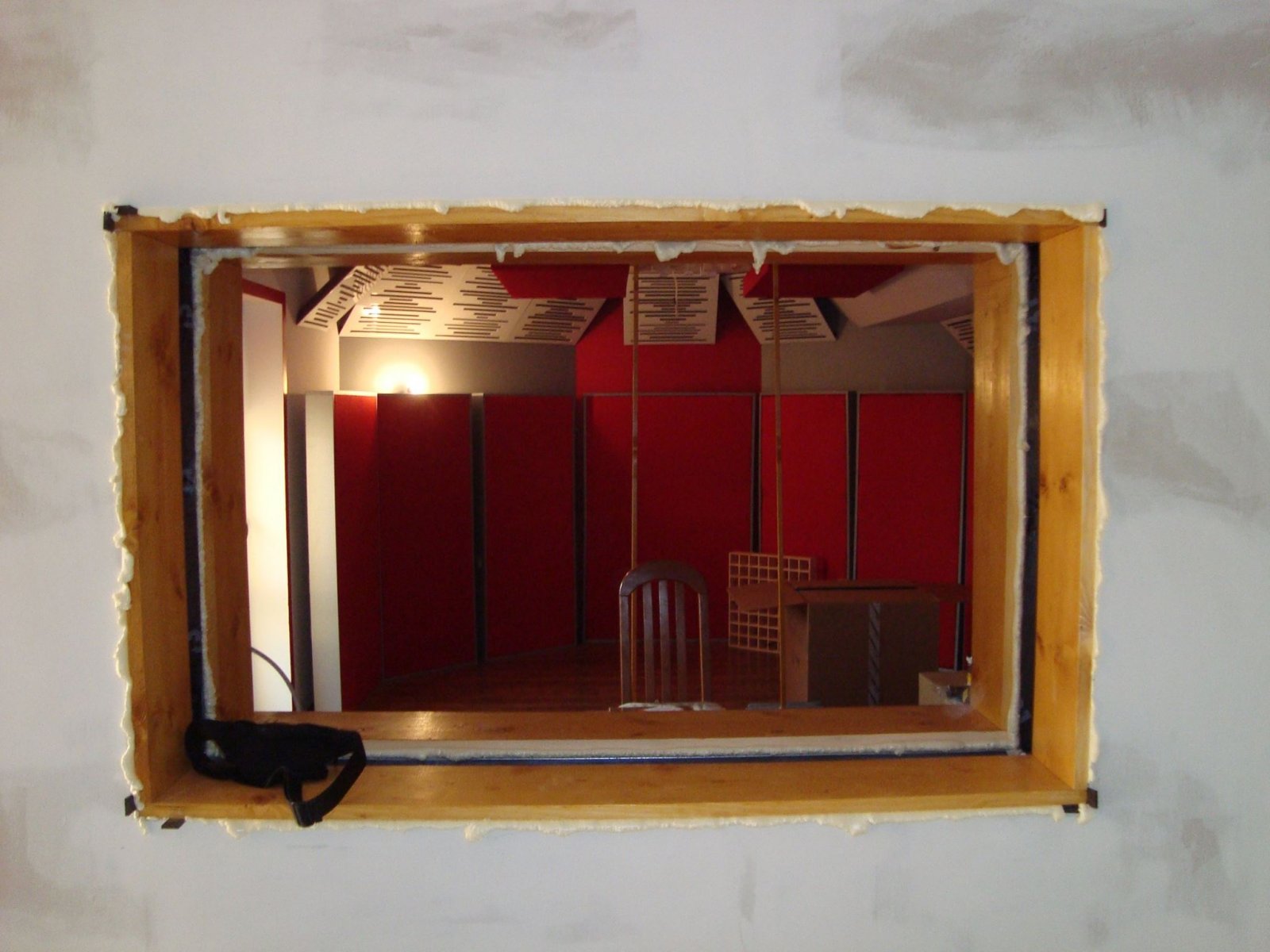



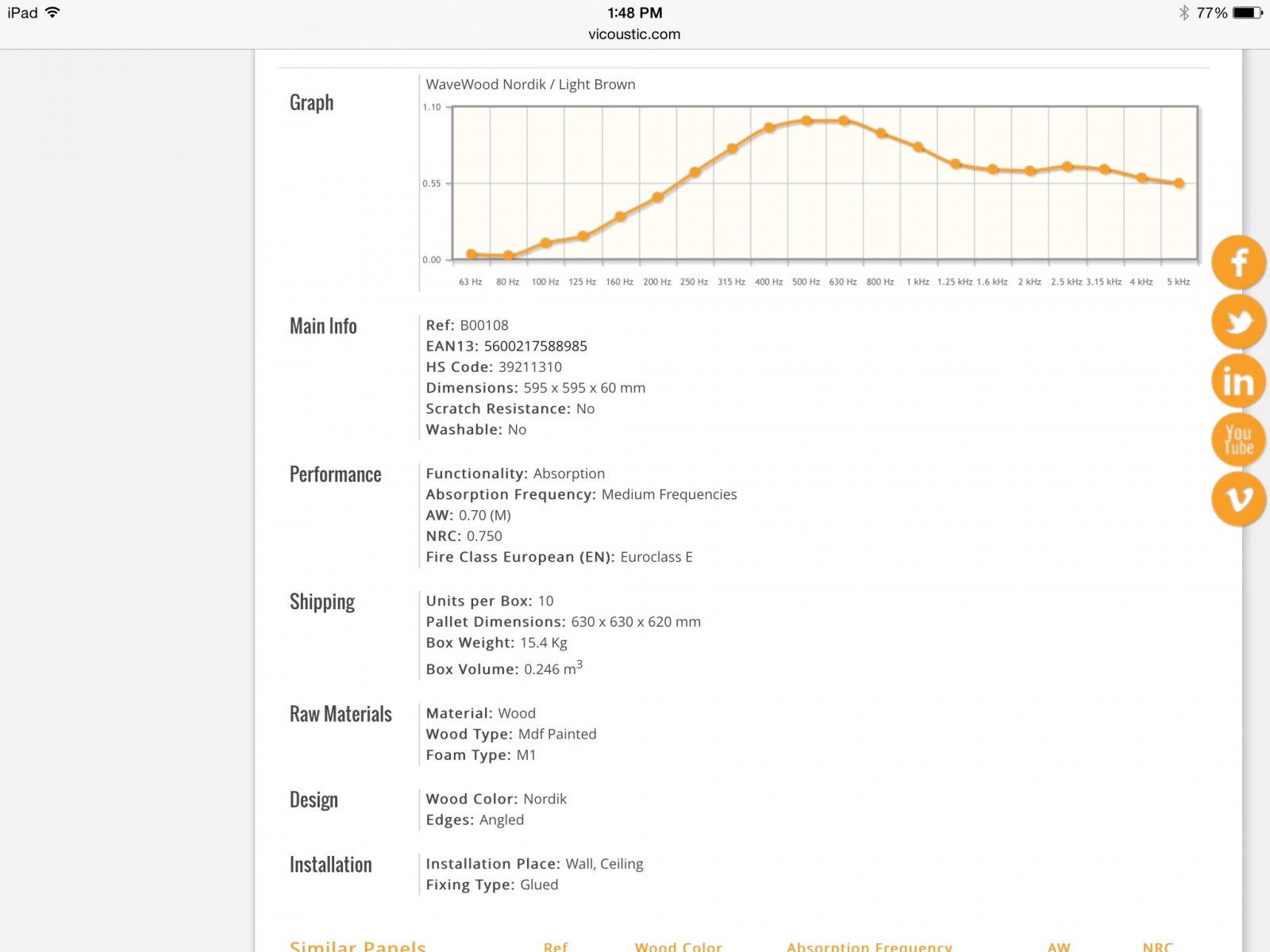


More pic... Attached files
More pic...
Attached files

